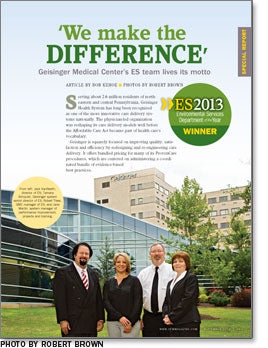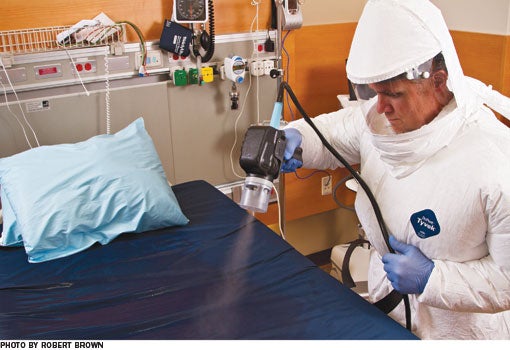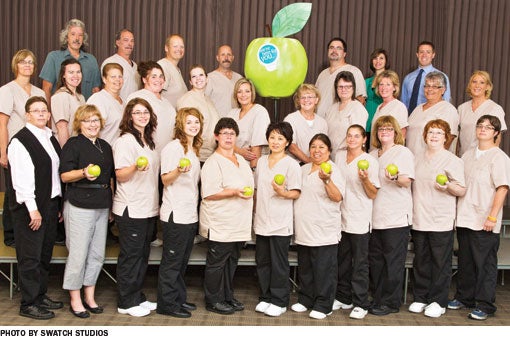We make the difference
 Serving about 2.6 million residents of northeastern and central Pennsylvania, Geisinger Health System has long been recognized as one of the more innovative care delivery systems nationally. The physician-led organization was reshaping its care delivery models well before the Affordable Care Act became part of health care's vocabulary.
Serving about 2.6 million residents of northeastern and central Pennsylvania, Geisinger Health System has long been recognized as one of the more innovative care delivery systems nationally. The physician-led organization was reshaping its care delivery models well before the Affordable Care Act became part of health care's vocabulary.
Geisinger is squarely focused on improving quality, satisfaction and efficiency by redesigning and re-engineering care delivery. It offers bundled pricing for many of its ProvenCare procedures, which are centered on administering a coordinated bundle of evidence-based best practices.
This organizational commitment to quality and safety extends far beyond the operating room. At Geisinger Medical Center (GMC), the system's 560-bed flagship hospital campus in Danville, the environmental services (ES) team employs a "bundled cleaning" approach to patient rooms.
ES associates follow a carefully defined six-step cleaning process with checklists for patient rooms, created by researcher Philip Carling, M.D. Every cleaning cart has a visual and text chart of Carling's 14 high-touch points that need to be cleaned as well as infection control checklists for daily cleans, discharges and isolation rooms. Supervisors use fluorescent marking gel and ultraviolet light to measure cleaning thoroughness of the high-touch points.
"We conduct 14 high-touch point fluorescent marker inspections, which are generated and then recorded into spreadsheets in various forms for reporting out to our infection control and performance improvement committees," explains Jack VanReeth, GMC's director of ES and surgical cleaning services.
Bundled cleaning
This bundled cleaning approach has become part of GMC's culture. The ES team has a consistently high success rate: More than 90 percent of GMC's rooms are 100 percent compliant for thoroughly cleaning all 14 high-touch points, ES department data from 2012 show.
Elsewhere, ES leaders working with the infection prevention team have widely implemented other technologies to improve safety.
Automated room sterilization technologies are deployed routinely to combat Clostridium difficile, methicillin-resistant Staphylococcus aureus (MRSA) and other health care-associated infections. GMC uses three ultraviolet-C (UVC) light units and three hydrogen peroxide (HP) vapor sterilization units across its facilities.
"The primary focus is on isolation discharges of various types and also to see if a room needs to be treated retroactively," VanReeth says. "All patient room isolation discharge cleanings always include wall washing and changing cubicle curtains. General isolation discharges receive a supplemental UVC disinfection. C. difficile discharges after the regular isolation cleaning receive a supplemental disinfection with a sporicidal product. Then, as a final step, the C. difficile room receives a hydrogen peroxide fumigation treatment."

High-tech sterilization
The HP vapor units take far longer to sterilize a room — typically 90 minutes to two hours. VanReeth notes that it's because there is no short-term exposure time limit established with HP, which is one part per million. As such, once the room is decontaminated, patients aren't admitted until the space reaches the one-part-per-million threshold or less.
This closely monitored approach and careful coordination with the infection prevention team is paying dividends. Since implementing the HP vapor system in mid-December 2011, GMC's C. difficile rate has been cut by 30 percent to 0.23 percent of unit discharges, VanReeth says, adding that no other changes were made to cleaning protocols. Since implementing UVC technology in 2012, MRSA rates have decreased 25 percent to 0.4 percent of discharges, again with no other changes to established cleaning and disinfection protocols.
This commitment to performance improvement on reducing health care-associated infections (HAIs), consistently adhering to defined protocols and overall safety is one key reason GMC has been selected winner of the 2013 ES Department of the Year competition. Presented by Health Facilities Management and the Association for the Healthcare Environment (AHE), the award is sponsored by Cintas Corp.
"Achieving ES Department of the Year status is no easy feat. The determination of the Geisinger Medical Center ES team is outstanding," says Patti Costello, executive director of the AHE.
Training is key
That GMC has seen such consistent results on room cleaning and working closely with the infection prevention team to reduce HAIs can be traced back to the fundamentals. Detailed training of new hires from ES team leadership helps to set the tone for expectations and departmental standards. Current staff also participate in regular training.
"Our greatest strength is our people. We have to invest as much as we can in our staff because it's a service we're providing and people are providing the service," says Tamara D. Almquist, Geisinger Health System senior director of environmental services and surgical services.
That investment starts before employees are hired. GMC, which is one of the employers of choice in this economically challenged area of Pennsylvania, developed a departmental recruitment video. It's used to help give applicants comprehensive information to determine whether to proceed with the application process.
Once on board, new hires go through intensive education at a training site off campus.
"It's a classroom style with eight modules presented by the ES management team. There's a session where they observe a discharge room being completely cleaned and an occupied patient room being cleaned," says Jane Martin, R.N., CIC, manager of performance improvement, projects and training for Geisinger System environmental services.
Attendees also are taken through a product display room to learn about the cleaning and disinfectant agents they'll be using in their daily routine. Once entered into the workforce, ES associates log into the hospital's online education program goals system and take a survey. Based on the answers provided by the associate, a list of hospital courses are provided that the employee will need to take on an annual basis. Continuing education expectations are similarly high for experienced employees.
Employee retention
Based on GMC data, this approach to giving ES associates a strong foundation in working efficiently and effectively is connecting with staff. GMC's ES associate retention rate over the past three years has averaged nearly 80 percent. And many of those who end up leaving the ES department moved on to higher positions within GMC.
More importantly, having well-trained and motivated staff has helped GMC to maintain a consistently strong success rate in reducing room turnaround and response times to meet the demands for increased throughput on this extremely busy campus.
Response times in 2012 were routinely in the 10-minute range for "clean next" rooms, based on GMC's bed tracking data. Stat clean response times in 2012 routinely were in the two-minute range or less — an impressive feat for a team responsible for more than 2.4 million square feet of cleaning space.
"This is a significant responsibility for us because, being a regional trauma center, our emergency rooms are constantly packed and we have very busy operating rooms, so turnover is absolutely critical," VanReeth says.
And with an extensive array of tertiary facilities, including ever-expanding outpatient services, GMC's ES department is responsible for covering a lot of ground outside the main hospital walls — all of which can make maintaining consistently high levels of patient satisfaction challenging.
After achieving Press Ganey Associates Inc. room cleanliness scores in the 89th percentile for institutions with 500 beds or above in 2011, GMC's numbers dipped in 2012.
But as with other areas of operation, the team leadership has taken steps, in working with the Studer Group, Gulf Breeze, Fla., to implement training and tracking mechanisms designed to boost performance on cleanliness and courtesy. Finally, GMC's ES team continues to make significant strides in environmental stewardship. An effort to reduce regulated or red bag medical waste, begun in 2011, led to a reduction of 584,000 pounds or 292 tons of this waste for an annual savings of about $82,000. In 2012, red bag waste was reduced by another 160 tons, bringing additional savings of nearly $45,000.
Making a difference
The effort to reduce red bag waste involved ES employees throughout the campus. As with its other areas of operation, it's an example of how GMC's ES team lives its motto of "We make the difference."
Bob Kehoe is associate publisher of Health Facilities Management.
Winner
Geisinger Medical Center
• Danville, Pa.
• Jack VanReeth, director of environmental services and surgical cleaning services
Finalist
Blanchard Valley Hospital
• Findlay, Ohio
• Robin Cramer, environmental services/communications manager
Certificate of Merit
MD Anderson Cancer Center
• Houston
• Alonzo Gonzalez, CHESP, CHFM, director of patient care facilities properties
Huntsman Cancer Hospital
• Salt Lake City
• Linda C. Rogers, manager of environmental services
Judges
• Laurie Bowe, CHESP, environmental services supervisor, Shriners Hospitals for Children, Erie, Pa.
• J. Hudson Garrett Jr., Ph.D., senior director, clinical affairs, PDI Inc., Orangeburg, N.Y.
• Ali Khan, CHESP, manager of environmental services, University of Maryland Shore Medical Center at Easton
• Doug Rothermel, MBA, CHESP, director of environmental services, St. Joseph's Hospital, Tampa, Fla.
FINALIST
'Extraordinary people. Exceptional care'
Blanchard Valley Hospital ES team goes the extra mile

In the ever-expanding world of health care marketing, physicians, nurses and executive leaders are getting plenty of face time these days. At Blanchard Valley Hospital (BVH) in Findlay, Ohio, things are different.
There, the community is just as likely to hear from environmental services (ES) associates and other department-level staff in TV and radio spots that trumpet the organization's vision: "Extraordinary People. Exceptional Care."
It may seem like a little thing. It's not. Not to those featured in the spots and not to the ES department leadership.
"What these associates do every day, what they bring to this job — they have the ability to be out there and to be recognized as partners vs. being an employee. They're not at the bottom of the totem pole," says Robin Cramer, manager of environmental services and communications.
The bottom is one place you'll never find the BVH ES team when it comes to performance and improving safety.
Compiling a stellar record in areas like patient satisfaction on room cleanliness and courtesy, reducing room turnaround times and maintaining a 95 percent hand-hygiene compliance rate, Cramer and her colleagues for the second straight year received the Finalist award in the 2013 ES Department of the Year Award competition. They earned the top score among hospitals with 150 beds or fewer.
The award, sponsored by Cintas Corp., is issued jointly by Health Facilities Management and the Association for the Healthcare Environment and recognizes top-performing environmental services teams based on 14 criteria measured in entrants' applications.
Judges recognized the BVH ES team for continuous performance improvement throughout the 150-bed facility and its ability to continually expand services to meet patient and organizational needs.
Hospitality matters
This latter point perhaps best illustrates what makes the BVH ES team so successful. They continually work with other departments to improve overall performance, often expanding their responsibilities in the process.
The ES team complements nursing by responding to call lights, spending time with patients to help them order meals and understand how to use safety pull cords or the television controls. ES associates, or "hospitality associates" as they are called, stepped in to cut the time it takes to get med-surg and orthopedics/neurology patients who are discharged to their cars from an average of roughly 25 minutes to five to seven minutes.
Elsewhere, ES staff collaborated with nursing, quality and patient safety leaders to identify patient fall risks. The effort led to a 10 percent reduction in patient falls last year. ES teamed with nursing to implement a quietness campaign in 2012 that boosted HCAHPS scores in this area to 76.7 percent from 71 percent the prior year.
The ES team's willingness to help others, whether patients or other staff members, is reflected in BVH's Press Ganey and HCAHPS scores. Its HCAHPs top box scores for room cleanliness, meaning patients surveyed indicated the room was "always" clean, hit 83 percent in 2012, up slightly from the year prior. Press Ganey scores for room cleanliness and courtesy of the person cleaning the room were both in the 98th percentile, nearly identical to the year before.
"Our associates create that emotional connection with patients that gets us those top box answers," says Leslie Theis, R.N., service excellence and patient relations liaison at BVH. "One reason the department is so successful is because [staff] are consistent every day, every shift. Their message is the same. They hold each other accountable and take great pride in their work and that goes from the top down and the bottom up."
So whether it's using adenosine triphosphate to measure cleaning thoroughness of high-touch points in patient rooms or teaming with inpatient and wound care nurses on assessing mattresses and linens to help reduce pressure ulcers, the front-line associates drive continuous improvement.
"The front-line people have brought us to where we are," Cramer says. "If they didn't go into those rooms, talk with those patients and if their work ethic wasn't what it was, we would have a black hole. Depending on them is key to what we do."
Bob Kehoe is the associate publisher of Health Facilities Management.


